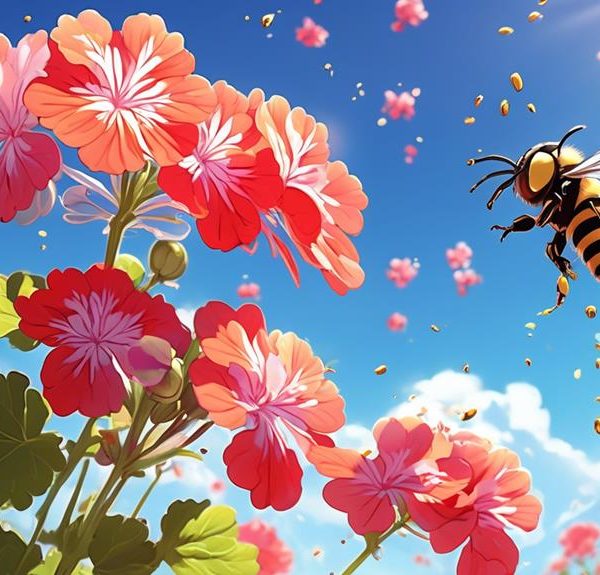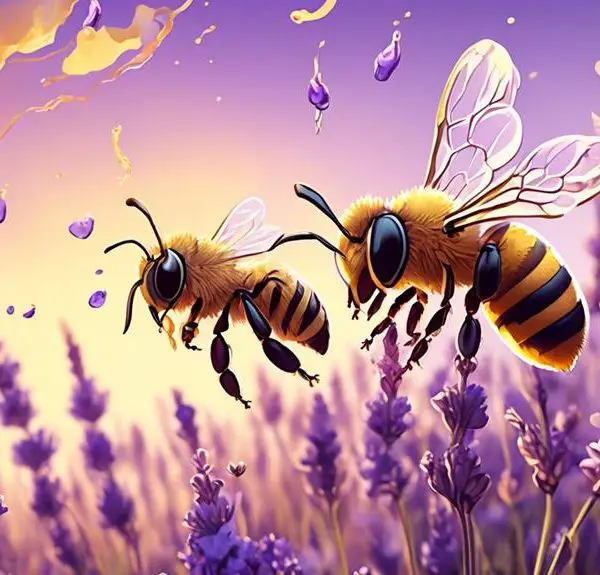Investigate the intriguing relationship between bees and heat, a tale of biology, behavior, and adaptation waiting to be unveiled.
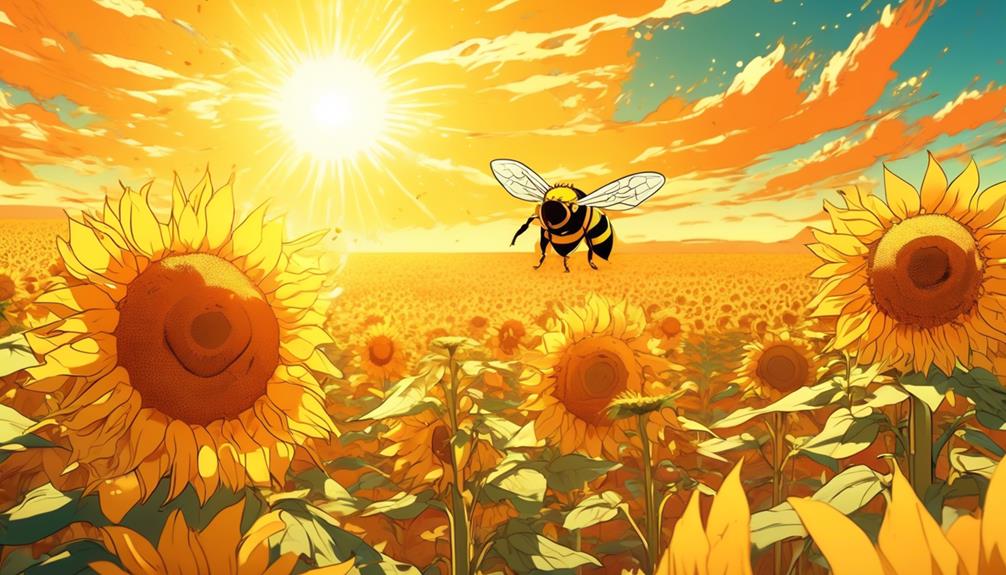
Do Bees Like Heat?
Just as a candle must endure the heat to give off light, bees too have a special relationship with temperature. You may have noticed that these industrious insects are more active in the warmer months, buzzing from flower to flower in the summer sun. But do bees actually like the heat, or is it a necessary challenge they must overcome?
It's a fascinating question, and the answer involves a complex dance of biology, behavior, and adaptation. There's more to their relationship with heat than meets the eye, so let's uncover the intriguing secrets of their thermal world.
Key Takeaways
- Bees rely on environmental factors for thermoregulation and cannot internally regulate their body temperature.
- High heat levels can significantly impact bees' behavior, foraging patterns, and navigational abilities.
- Bees have survival tactics in hot weather, such as fanning wings, evaporating water for cooling, and reducing activity during the hottest parts of the day.
- Temperature plays a crucial role in bee pollination, and extreme heat can negatively affect their efficiency, as well as the quality and quantity of nectar produced.
Understanding Bee's Thermoregulation
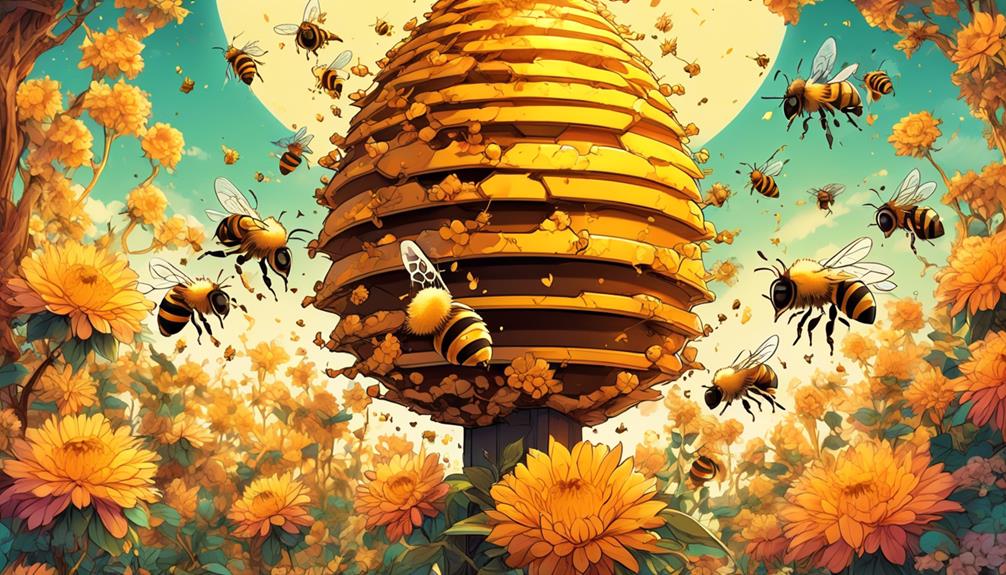
Diving into the world of bees' thermoregulation, it's crucial to understand that bees, unlike humans, can't regulate their body temperature internally, and instead rely heavily on environmental factors and group behavior to maintain an optimal temperature. This reliance is primarily due to their exoskeleton structure which lacks insulating fat layers.
Bees have evolved remarkable strategies to cope with temperature changes. They aggregate to form a 'bee cluster' during cold weather, where worker bees generate heat by flexing their flight muscles while the queen and brood remain in the warm core. This clustering behavior is a fascinating example of social thermoregulation.
In contrast, during hot weather, bees employ a cooling mechanism akin to air conditioning. You'll observe bees fanning their wings to circulate air and reduce hive temperature. Some bees even fetch water, which evaporates to cool down the hive.
Understanding bees' thermoregulation has significant implications for bee conservation, particularly in the face of climate change. Your knowledge about this can contribute to creating conducive environments for bees, ensuring their survival and, consequently, our own. Bees, after all, are essential pollinators in our ecosystem.
Impact of Heat on Bee's Behavior
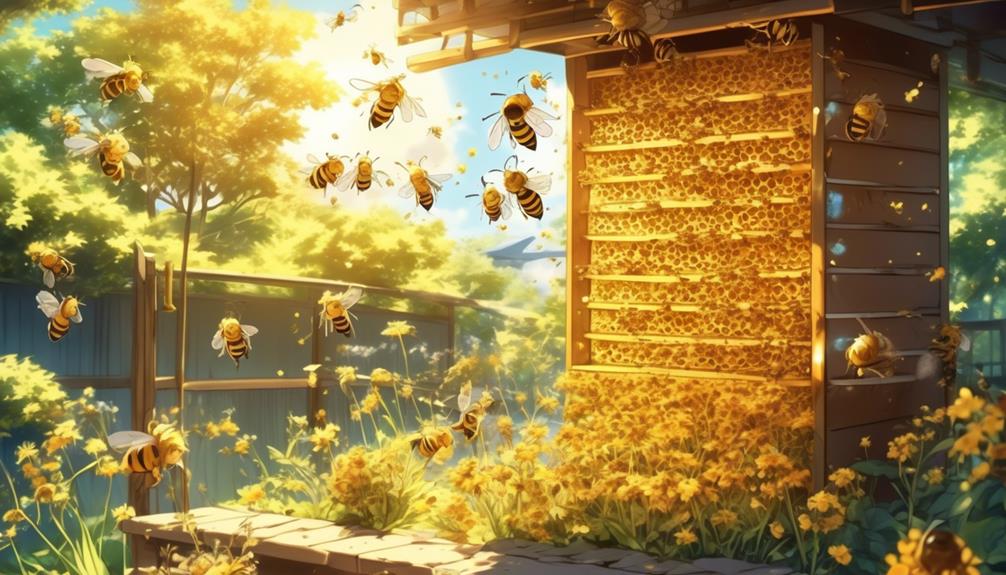
As the mercury rises, it's important to note how increased heat levels can significantly alter a bee's behavior, leading to changes in their daily activities and overall survival strategies.
In particular, bees respond to temperature changes by adjusting their foraging patterns. On hot days, you'll notice that bees start their foraging activities earlier in the morning or later in the evening when temperatures are more bearable. This adjustment helps them avoid the intense heat that can be detrimental to their health and productivity.
Heat stress can also affect a bee's navigational abilities. High temperatures can interfere with their ability to communicate and locate food sources, leading to decreased colony efficiency. Moreover, it can trigger aggressive behavior, causing bees to attack perceived threats more readily.
However, it's not just the individual bees that suffer. Heat also impacts the hive as a whole. If the temperature inside the hive becomes too high, bees fan their wings to cool it down, diverting energy from other important tasks. Prolonged exposure to extreme heat can also lead to the death of the brood, severely impacting the future generation of the hive.
Bees and Their Hot Weather Survival Tactics
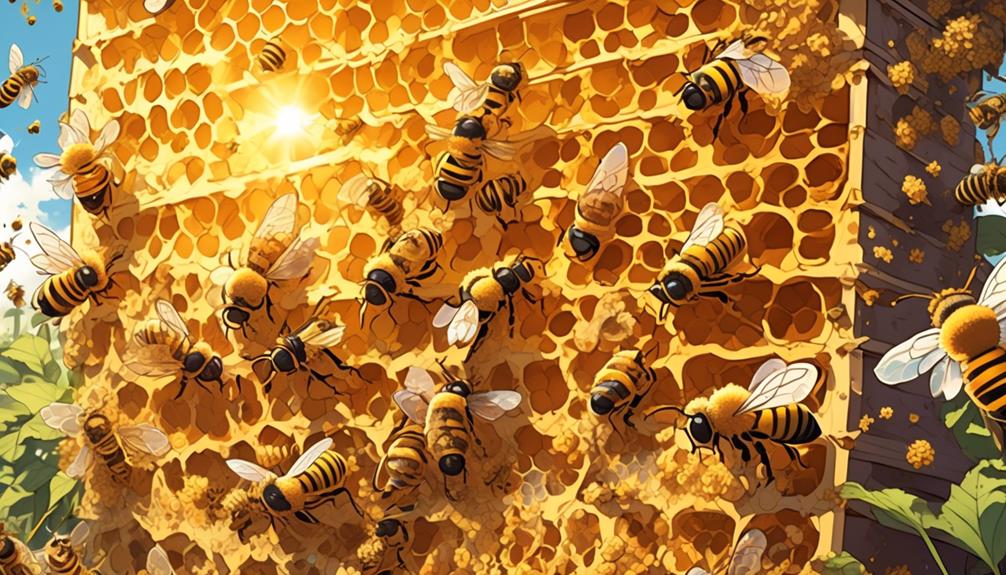
Despite the challenges posed by high temperatures, bees have developed impressive survival tactics that often come into play during hot weather conditions. If you observe closely, you'll notice that bees regulate their hive's temperature by fanning their wings at the entrance, creating an air conditioning effect. They're not just cooling the hive, they're also evaporating water collected specifically for this purpose.
Simultaneously, other bees are dispatched to collect more water, showing a level of organization and division of labor that's quite remarkable. Additionally, bees will often reduce their activity during the hottest parts of the day, conserving energy and reducing heat production within the hive.
Another fascinating tactic is cluster formation. In extreme heat, bees form clusters and leave gaps in the comb to allow air circulation. If temperatures rise too high, they can even abscond, leaving the hive altogether.
Moreover, beeswax, the material bees use to construct their hives, has a high melting point, which protects the hive structure from extreme heat.
The Role of Temperature in Bee's Pollination
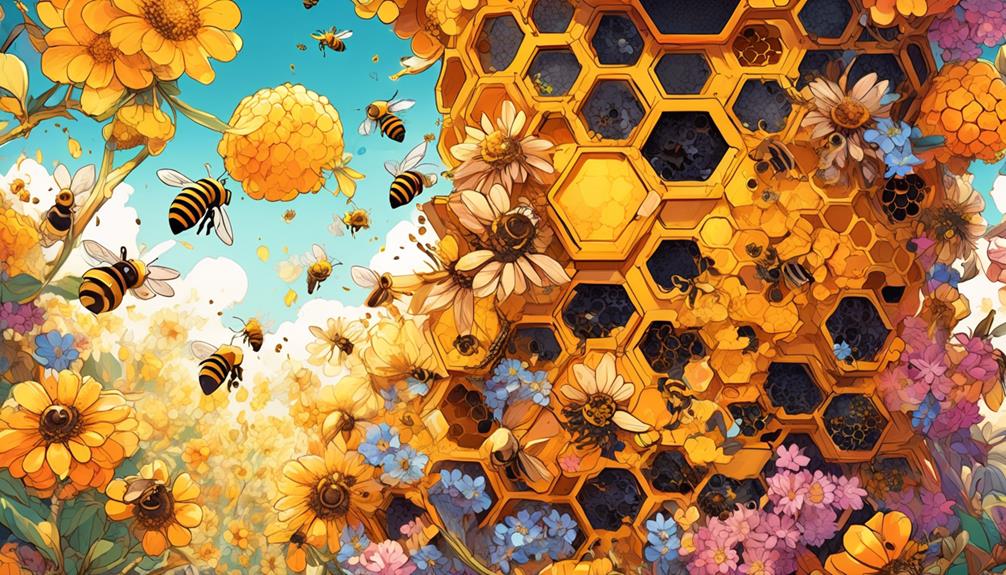
While bees employ these heat survival tactics, it's also crucial to consider how temperature influences their vital role in pollination. You see, temperature plays a pivotal part in the pollination process. Bees need a certain level of warmth to be active. If it's too cold, their metabolism slows down, and they can't fly or gather nectar. Conversely, if it's too hot, they risk overheating and dehydration.
In a study published in the journal Ecology, researchers found that bees' pollination efficiency decreases significantly in extreme heat. They observed that bees visited flowers less frequently during hotter periods and spent less time on each flower, thereby reducing the number of pollen grains transferred. Moreover, high temperatures can affect the quality and quantity of nectar produced by plants, further limiting food resources for bees.
Therefore, while bees may tolerate heat to some degree, their pollination performance is adversely affected by extreme temperatures. This delicate balance between temperature and pollination is integral to the survival of not only bees but our entire ecosystem. Understanding this interaction is key to predicting the potential impacts of climate change on bees and, by extension, global food production.
How Bees Cope With Summer Heat
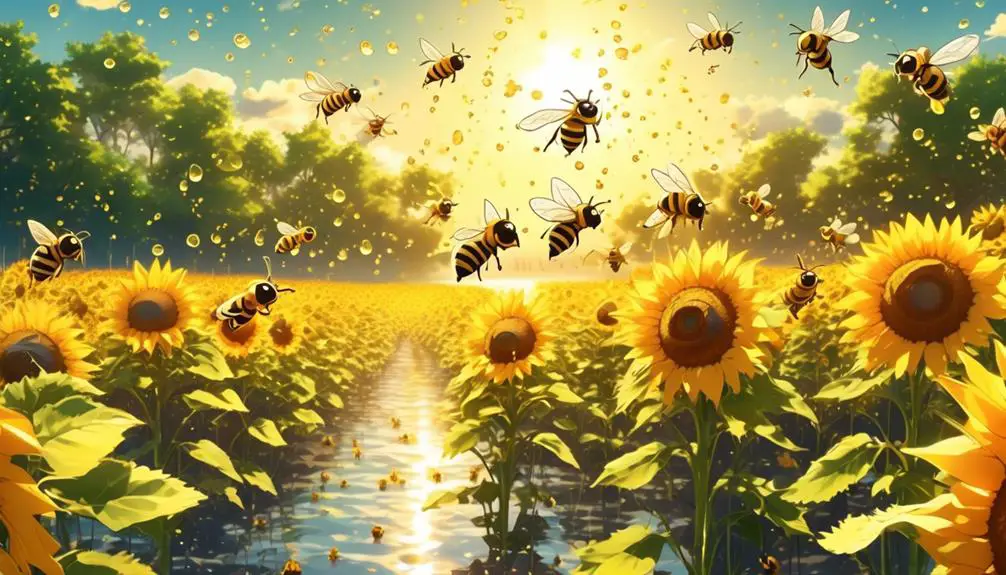
In the sweltering summer months, bees employ a range of impressive strategies to beat the heat and maintain their crucial role in our ecosystem. You might see bees gathering at the hive entrance, fanning their wings. They're not just lazing around; they're actively cooling their hive.
This behavior, known as 'bearding', is the bees' natural air conditioning system. They force cooler air into the hive, reducing the internal temperature. It's an energy-intensive process, but it's essential for the survival of the colony. The larvae, in particular, need steady temperatures to develop correctly.
Bees will also collect and distribute water throughout the hive. They deposit tiny droplets on the brood combs, which evaporates and cools the hive, similar to how sweating cools us down.
They're even capable of 'thermoregulatory fluttering' – contracting their flight muscles without moving their wings. This generates heat, which can be essential when cooler temperatures strike unexpectedly.
In extreme conditions, bees may abandon their hive temporarily, clustering nearby until temperatures drop. It's a drastic measure, but sometimes necessary for survival.
Adapting Hives for Higher Temperatures

As temperatures rise globally, it's vital to adapt your bee hives to withstand the increased heat. Bees have a remarkable ability to regulate the temperature of their hive, but extreme conditions can challenge even the hardiest of species.
Firstly, consider the hive's location. It should be in a place that offers shade during the hottest parts of the day, but also receives morning sunlight. The balance between sun and shade helps bees maintain an optimal hive temperature.
Secondly, adequate ventilation is crucial. You can achieve this by slightly elevating the hive off the ground or by incorporating a screened bottom board. This allows air to circulate, helping to dissipate excess heat.
Lastly, ensure your bees have a continuous supply of water nearby. Bees use water to cool their hive through a process akin to evaporative cooling in humans. They spread water over the brood comb and then fan it with their wings, causing the water to evaporate and cool the hive.
Frequently Asked Questions
How Does Heat Affect the Lifespan of a Bee?
Heat can significantly impact a bee's lifespan. If it's too hot, you'll notice bees can't survive long as it affects their metabolism and behavior. They'll spend more energy trying to cool their hive and less on gathering food. Also, extreme heat can damage their wings.
What Are the Signs of Heat Stress in Bees?
Signs of heat stress in bees are quite noticeable. You'll see them fanning their wings at the hive entrance, essentially acting as living air conditioners. They'll also consume more water than usual. Bees might even stop foraging, as high temperatures can be detrimental.
If the hive gets too hot, they'll implement a process called bearding, where they cluster outside the hive. It's their way of managing temperature and ensuring survival.
How Does Heat Influence a Bee's Honey Production?
Heat significantly impacts a bee's honey production. When it's too hot, bees spend more time cooling the hive than making honey. They'll fan their wings to circulate air and bring in water to evaporate for cooling. This energy expenditure decreases their honey production.
Are There Specific Bee Species That Are More Resistant to Heat Than Others?
Yes, there are specific bee species more resistant to heat.
For instance, the Africanized honey bee, known for its ability to tolerate high temperatures, thrives in warm climates. They've got a superior heat tolerance mechanism compared to other bee species.
However, it's crucial to note that extreme heat can still adversely affect these heat-resistant species, disrupting their normal activities and potentially reducing their honey production.
What Strategies Can Beekeepers Use to Protect Their Hives From Extreme Heat Apart From Adapting the Hives?
As a beekeeper, you can utilize several strategies to safeguard your hives from extreme heat.
Ensure proper ventilation to promote air circulation.
Use lighter colored hive boxes to reflect sunlight.
Maintain a water source nearby for bees to cool themselves.
Shade can also be beneficial, but don't obstruct the hive entrance.
Regularly monitor your hives for signs of heat stress, adjusting your strategies as needed.
Conclusion
So, do bees like heat?
Not particularly. They've developed impressive strategies to survive high temperatures, like thermoregulation and hive adaptations.
But remember, too much heat can impact their behavior and pollination role.
As summer approaches and temperatures rise, it's crucial for us to understand how these tiny pollinators cope with heat and how we can help them thrive in these challenging conditions.
After all, their survival is intrinsically linked to ours.

